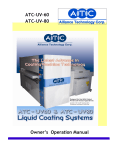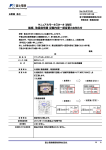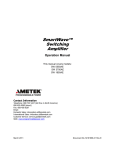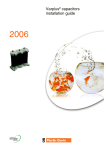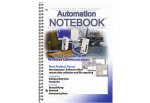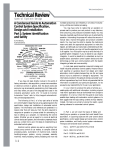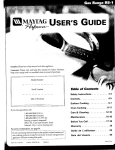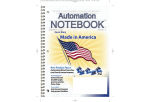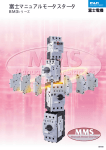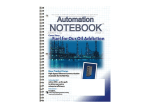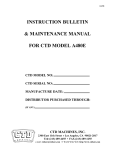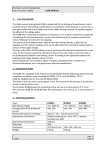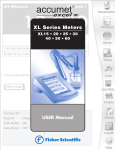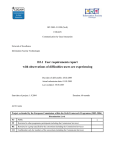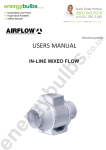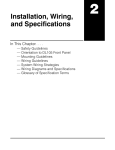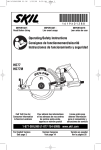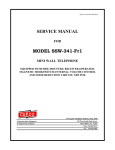Download Automation Notebook: Online Technical Magazine
Transcript
0508_AutomationNotebook_issue5_final.qxd 3/15/2006 7:58 PM Page 1 0508_AutomationNotebook_issue5_final.qxd 3/15/2006 7:58 PM Page 2 Automation Notebook Fall 2005 Issue Five Your guide to practical products, technologies and applications Contributors Publisher Tina Crowe Managing Editor Keri Schieber Senior Editor Design Manager Justin Stegall Contributing Writers Phil Simmons Jeff Payne Chip McDaniel Steven Noto Tom Elavsky • Control Design magazine’s Readers’ Choice Awards 2001 best service of any supplier for PLC Hardware and PLC Software • Control Design magazine’s Readers’ Choice Awards 2002 best service of any supplier for PLC Hardware and PLC Software CONTACTS Automationdirect.com Inc. 3505 Hutchinson Road Cumming, GA 30040 • Control Design magazine’s Readers’ Choice Awards 2003 best service of any suppler for PLC Hardware, Operator Interface, and Terminal Blocks; received the highest scores of any supplier • Control Design’s Readers’ Choice Awards 2004 - best service of any supplier for PLC hardware, I/O Systems, and Terminal Blocks • Control magazine’s Readers’ Choice Awards 2004 - best service of any supplier for PLC Hardware, PLC Software, Operator Interface, and Power Supplies • Control Engineering’s Customer Satisfaction Survey 2004 - top service rankings in I/O Products, Operator Interface Hardware and Software, and PLC Hardware/Software Linda Donegan Phone . . . . . . . . . . 1-800-633-0405 or 1-770-889-2858 Fax . . . . . . . . . . . . . 1-770-889-7876 Monday - Friday 9 a.m. to 6:00 p.m. EST www.automationdirect.com AutomationDirect is committed to bringing you the best automation products at prices that won’t break your budget. With a selection of over 5,500 quality industrial control products, backed by consistent service, you should give us a call at 1-800-633-0405 or check us out at www.automationdirect.com. Low prices, fast shipping, and superior service backed by experience. For over 10 years, we’ve been committed to treating our customers to an exceptional industrial control buying experience. Our team consists of some of the best veterans from the industry giants with field-tested knowledge in a wide variety of applications. • • • • • • • • PLCs Field I/O Software Operator Interface Drives/Motors Motor Controls Stepper Systems Sensors • • • • • Pushbuttons/Lights Process Controllers Relays/Timers Communication Terminal Blocks & Wiring • Circuit Protection • Power Supplies • Enclosures . . . and more! Call or go online to request your FREE 1,750-page catalog today! Copyright 2005, Automationdirect.com Incorporated/All Rights Reserved No part of this publication shall be copied, reproduced, or transmitted in any way without the prior, written consent of Automationdirect.com Incorporated. Automationdirect retains the exclusive rights to all information included in this document. Editor’s Note Summer is winding down, the kids are back in school, and if you've been distracted by vacations and sunny weekends, you're probably thinking it's time to get your mind back on work. At AutomationDirect, we've had our minds focused on lots of work. Early summer saw some of us moving, at last, into the building next door. It took longer than anticipated to get the facility ready, but thanks to great planning and teamwork, we're settled in and managed the move without any major issues. I was hoping we'd have stories to tell about an incident or two, but the whole process went off without a hitch. One of the more exciting elements was the purchase of a golf cart that we use as a taxi between the buildings. While waiting on our office renovations, we concentrated on putting out our 2005 catalog (Vol. 10). It's amazing how much team effort goes into producing it. This one is over 1,750 pages filled with more than 5,500 parts, including many new ones. If you haven't received it yet, please fill out the request form on page 7 of this publication, and we'll send one out right away. This issue of Automation Notebook focuses on the release of the 2005 NEC. We invited Phil Simmons of Simmons Electrical Services to discuss some of the changes. I hope you find the articles informative and as always, we'll appreciate any feedback you send our way. Keri Schieber Managing Editor [email protected] www.automationnotebook.com Table of Contents New Product Focus 4 Rhino Power Supplies Product Snapshots 6 DataNet OPC, Edison Fuses, H0-ECOM100 Cover Story 8 2005 NEC® Code Changes PLC Speaking 12 The Evolutionary PLC: Past, Present and Future Business Notes 13 Goings-On in the Automation Industry User Solutions 14 Downtime Monitoring With PLC Technology Feature Story 15 2005 DARPA Grand Challenge Technology Brief 21 EN418 Directive Tech Thread 22 Numbering Systems Explained Technical Review 24 A Condensed Guide to Automation Control System Specification, Design and Installation Part 3: Design FYI 28 How to Wire a Motor Starter The Break Room Time to Celebrate 30 0508_AutomationNotebook_issue5_final.qxd 3/15/2006 7:59 PM Page 4 New Product Focus what’s New Rhino™ series offers variable DC switching power supplies A utomationDirect now offers the RHINO line of power supplies, which includes several new metal and plastic-housed switching supply models. The new RHINO PSM series power supplies are industrial grade switching DC output supplies with a sturdy steel case to withstand harsh environments. Autoselect inputs for 115 VAC or 230 VAC and international agency approvals make the RHINO PSM series suitable for worldwide use. RHINO PSM power supplies are available in 12 or 24 VDC output, with adjustable output voltages, and feature low output ripple along with overload and overtemperature protection. The seven models offer power ratings from 78W to 600W, and up to 25A output current. Each power supply includes two diagnostic discrete outputs for monitoring lowoutput voltage levels, allowing for remote notification to a PLC, SCADA or Maintenance Management System. One output is a transistor device that can be directly connected to the logic input of an I/O device, such as a PLC, for remote monitoring and annunciation of low voltage levels. The other output is a relay output that can be connected to any drycontact capable device and will open its contact when the output voltage drops. Additionally, each PSM unit can be 4 configured for Remote ON/OFF activation by wiring the Remote ON/OFF terminal in series with a relay or I/O device and the Vout terminal. This allows any logic device, PLC or remote I/O node to activate or deactivate the power supply output power for easy system startup/shutdown or maintenance purposes. RHINO PSM power supplies also include multiple output terminals to facilitate wiring in parallel load configurations, dual status indicator LEDs, and a pluggable screw terminal block for quick installation and removal. Prices for PSM models start at $86 for the 24V/3.75A model. The PSM power supplies comply with the latest EMC immunity and emissions standards for industrial environments. There is also a model in this series that complies with NEC Class 2 safety requirements. The Mean Time Between Failure (MTBF) reliability is greater than 350,000 hours, in accordance with the IEC 61709 standard. Innovative add-on modules for the RHINO PSM line include a Redundancy Module for configuring a true redundant power system with power sharing, a Battery Controller Module suitable for creating a DC Uninterruptible Power Supply (UPS) system by charging and monitoring an external battery; and a Buffer Module for maintaining output voltages of a 24 VDC power supply after brownouts or voltage dips. The Redundancy Module can connect two RHINO PSM power supplies to provide fully redundant output power and includes an alarm output signal when one of the power supplies has failed or has been disconnected. The Redundancy Module inputs are hot swappable for uninterrupted maintenance and can be loaded up to 15A each. For configuring a DC UPS, the Battery Controller Module provides a battery management system for charging and monitoring a lead-acid battery. The Battery Controller module also has an option for connecting an external temperature sensor that adjusts the battery charging voltage automatically to avoid overcharging and increase battery life. The Buffer Module uses a capacitor bank to store energy and is therefore maintenance free. The hold-up time of the Buffer Module is typically 200ms at 25A, and up to 4 seconds at 1.2A. Accessories for panel mounting are also available for the PSM power supplies. New RHINO PSP series power supplies are plastichoused ultracompact switching supplies available in 5V, 12V and 24V adjustable models. There are 14 models available with power ratings of 20W to 120W and up to 8A output current. They are DIN rail or panel-mountable and feature universal 85-264 VAC or 83-375 VDC inputs, adjustable DC voltage outputs, power good signal and low output ripple along with short circuit, overvoltage and overload protection. The PSP models start at $56 for the 24V/1A output model. The new RHINOTM line of power supplies includes metal and plastic-housed switching supply models for your control system’s DC power needs. RHINO PSM metal series switching DC power supplies are available in 12 or 24 VDC adjustable output models. Industrial Metal features: • • • • • • • • • Seven models offer power ratings from 78W to 600W, and up to 25A output current Steel case to withstand harsh environments Universal inputs for 115 VAC or 230 VAC International agency approvals suitable for worldwide use Low output ripple along with overload and overtemperature protection Includes two diagnostic outputs that indicate low-output voltage levels to a PLC, SCADA or CMMS Easy wiring for parallel loads using multiple output pluggable screw terminals Mean Time Between Failure (MTBF) 350,000 hours (IEC61709 @ 25oC) 3-year warranty RHINO PSP series power supplies are plastic-housed ultracompact switching supplies available in 5, 12, and 24 VDC adjustable output models. Slimline Plastic features: • 14 models available with power ratings of 20W to 120W and up to 8A output current • DIN rail or panel-mountable • Low output ripple along with short-circuit, overvoltage and overload protection • Power good signal • Featuring 85-264 VAC/DC universal input • 3-year warranty PSM Specialty Modules • • • Redundancy module Battery control module Buffer module For more information, visit: www.automationdirect.com/dcpowersupplies Check out our prices! Power Supplies AutomationDirect 24 VDC Output, Plastic Case 24 VDC Output, Metal Case 24 VDC Buffer Module, Metal Case Allen-Bradley Price/part number Price/part number $77.00 $110.88 PSP24-060C 60W/2.5A Output 1606-XLP50E 50W/2.1A Output $86.00 $151.00 PSM24-090S 90W/3.75A Output 1606-XL60D 60W/2.5A Output $189.00 $263.12 PSM24-BFM600S 1606-XLBUFFER Prices may vary by dealer. Many other part numbers are available from all vendors. All prices are U.S. list prices. AutomationDirect prices are June 2005 prices. A-B prices from http://www.ab.com 4/7/2005. 0508_AutomationNotebook_issue5_final.qxd 3/15/2006 7:59 PM Page 6 Automation Notebook Fall 2005 Issue Five Product Snapshots Press Releases DataNet OPC™ software is here that calculations be performed on the raw data before it is displayed. Visitors to this year's National Manufacturing Week were exposed to this feature firsthand when DataNet OPC was used, along with DataWorx, to compile and display test scores in the "Automation I.Q. Challenge." OPC technology allows easy and inexpensive data collection and display because it is supported by so many different devices. DataNet OPC is compatible with any industrial device that runs on an OPC 1.0 or OPC 2.0 compliant server. Edison fuse line has multiple applications Cumming, GA---May 4, 2005 ---AutomationDirect now offers DataNet OPC by BizWareDirect. This new software product keeps people connected to plant operations, without binding them to the confines of their facility. DataNet OPC uses Open Connectivity (OPC) technology to communicate live data from industrial devices to a Web page, with no HTML programming required. Data is then available for viewing, printing or archiving on any computer, anywhere the Internet or company intranet is accessible. For plants that use multiple PLC brands, DataNet OPC is able to provide a more unified approach to data display and logging. DataNet OPC offers many other useful features, designed to make industrial data more accessible and useful. Dynamic colors allow users to determine the status of their plant operations at a glance and can be used as an early warning system to alert personnel of abnormalities in operations. In addition, a math tool allows the user to request 6 Cumming, GA---May 12, 2005 ---AutomationDirect now carries products from the Edison line of fuse products. Edison Fuse is a subsidiary of Cooper Industries, the worldwide leader in circuit protection. All Edison fuses can be cross referenced and used as replacements for other name-brand fuses. AutomationDirect offers the most popular 13/32" x 1-1/2" models of the Current Limiting Class CC and the Class M Midget general purpose fuses for industrial control applications. Because of their current limiting performance, the Class CC products are sometimes regarded as an upgrade to the Class M general purpose fuses. The CC line is recognized for NEC branch circuit protection and Type 2 coordinated applications for IEC or NEMA starters/contactors. Where adherence to extensive current limiting codes is not required, the Class M general purpose midget fuses provide an effective solution for both time-delay and fast-acting protection. Primary among the applications for the Midget class are supplemental protection of end-use equipment as well as small motors, transformers, solenoids, and other high-inrush power circuits. All fuses are compact in size and offered in boxes of 10 at prices ranging from $7 to $50 per box. Also available are companion DIN rail-mount fuse holders and panel-mount fuse blocks. Ethernet Communication Module HO-ECOM100 The H0-ECOM100 can actively issue MODBUS commands to other nodes or devices on the MODBUS TCP/IP network, or simply respond to connected MODBUS TCP/IP clients. Link your PLCs with PCs using industry standard MODBUS TCP/IP protocol connected through standard cables, hubs, and repeaters. Or, use our KEPDirect I/O Server to link to your favorite HMI/SCADA, data historian, MES or ERP software to DirectLOGIC PLCs. Our LookoutDirect HMI and DataWorx data collection software include ECOM drivers. DirectSOFT32 Programming Software can be used to monitor or update the program in any DirectLOGIC PLC on the network. Free NetEdit3 Software ships with the ECOM Module User Manual to be used for setting up the ECOM modules for your network. ---Recently added to AutomationDirect's line of Ethernet communication products is the H0-ECOM100 module. Ethernet communication mod- The H0-ECOM100 supports the industry standard MODBUS TCP/IP Client/Server protocol in addition to the standard IP and IPX protocols. This allows a DL05 or DL06 PLC with an H0-ECOM100 module to serve as a client (master) or as a server (slave) on a MODBUS TCP/IP Ethernet network. Buy direct and get low everyday prices on industrial controls Get your FREE 1,750-page catalog with over 5,500 high-quality industrial automation components, with helpful selection guides, specifications and full price list. • • • • • • • • • • • • Cumming, GA---June 1, 2005 ules represent a price breakthrough for high-speed, peer-to-peer networking of PLCs. No longer are you forced to designate a single PLC to be the network master. Any PLC can initiate communications with any other PLC. Request your NEW FREE 1,750page Catalog PLCs Operator Interfaces AC Drives and Motors Sensors Motor Controls Pushbuttons and Lights Enclosures Connection Systems Communications Power Supplies and Protectors Relays Process Controllers Name Company “You see, wire telegraph is a kind of a very, very long cat. You pull his tail in New York and his head is meowing in Los Angeles. Do you understand this? And radio operates exactly the same way: you send signals here, they receive them there. The only difference is that there is no cat.” Address Type of Business: End user OEM Integrator Other – Albert Einstein, when asked to describe radio US (German-born) physicist (1879 - 1955) Fax your request to 770-844-4212 www.automationnotebook.com 7 0508_AutomationNotebook_issue5_final.qxd 3/15/2006 7:59 PM Page 8 Automation Notebook Fall 2005 Issue Five Cover Story Electrical Code 2005 NEC® Code Changes by Phil Simmons, Guest Writer T he purpose of the National Electrical Code® (NEC®) is the practical safeguarding of persons and property from hazards caused by using electricity. The NEC is prepared by a committee made up of a Technical Correlating Committee and 19 codemaking panels. The committee's responsibility is to create documents specifying code, which when adhered to, minimizes the risks of electricity as a source of electric shock and as a potential ignition source for fires and explosions. Published by the National Fire Protection Association, the NEC is updated every three years. Significant changes in the 2005 edition that we will be discussing are the new Article 409 and changes made to existing Article 430. standard for industrial control panels. Extensive substantiation was provided with the proposal for each of the new requirements. While the title of the article is Industrial Control Panels, the scope indicates the article applies to "… panels intended for general use." The new article is not limited to industrial occupancies but rather, has general application. The term "Industrial Control Panel" is defined in Section 409.2 as "an assembly of a systematic and standard arrangement of two or more components such as motor controllers, overload relays, fused disconnect switches, circuit breakers and related control devices such as pushbutton stations, selector switches, timers, switches, control relays, and the like with associated wiring, terminal blocks, pilot lights, and similar components. The industrial control panel does not include the controlled equipment." It should be noted that UL and other electrical testing laboratories have a procedure whereby a "panel shop" can produce control panels that comply with the UL Industrial Control Panel safety standard. As such, the control panels are eligible to bear the listing mark of the electrical testing laboratory. The internal wiring of these listed control panels is not usually inspected by the local electrical Industrial Control Panel inspector at the Article 409 time of installation, as provided in Article 409 covers industrial Section 90.7 of the NEC. On the other control panels intended for general use hand, the internal wiring of industrial and operating at 600V or less. A finecontrol panels that are built in accorprint note references Underwriters dance with new NEC Article 409 is Laboratories (UL) 508A as the safety usually subject to inspection by the local 8 Authority Having Jurisdiction (AHJ). This is due to the field-assembled control panels not being listed by a qualified electrical testing laboratory, but being assembled in accordance with NEC rules. If the AHJ determines the control equipment being field-assembled is an Industrial Control Panel, compliance with all conditions of Article 409 is required, including the extensive marking specification in 409.110. The NEC offers no explanation for the term "systematic and standard arrangement of two or more components" as included in the definition in 409.2. The question is raised since industrial control panels are often one-of-a-kind, designed to control a specific operation rather than being mass-produced. Rules are provided in 409.20 on sizing a supply conductor to the industrial control panel. These conductors will often meet the definition of a "feeder conductor" in the NEC Article 100. In this application, a feeder conductor is a set of conductors that usually has overcurrent protection on the supply side and terminates at equipment where branch circuits originate. The supply conductors to the industrial control equipment must be no smaller than 125 percent of the full-load current rating of all resistance heating loads, plus 125 percent of the full-load current rating of the largest motor, plus the fullload current of all other motors and apparatus supplied. An adjustment can be made based on the duty cycle of the equipment. See 430.22(E) for the application of multipliers for motors that operate under a duty-cycle concept. Overcurrent protection of field-assembled industrial control panels must comply with the requirements of Article 240, Parts I, II and IX. Part I includes the general rules for overcurrent protection, Part II provides requirements on the location of overcurrent protection, and Part IX provides rules on overcurrent protection for over 600V nominal. Disconnecting means for industrial control panels that supply motor loads must meet rules for disconnecting motor controllers in Article 430, Part IX. This generally requires a disconnecting means on the supply side of the controller and within sight of the controller (defined in Article 100 as visible from and not more than 50 feet away). Requirements for grounding industrial control panels must generally comply with Article 250. Specific requirements are provided in 409.60. Construction requirements for industrial control panels are found in Part III of Article 409. Rules are provided for enclosures, installing busbars and conductors, wiring space, and for where the control panel can be used as service-entrance equipment. Extensive marking requirements are contained in 409.110, including the short-circuit current rating of the assembly. A fine-print note refers to UL 508A-2001, where an approved method for determining the short-circuit current rating can be found. Rules in other standards might apply to specific control panels such as NFPA 79 for industrial machinery. Article 430 Several changes to Article 430 were made for the 2005 NEC. This includes some reorganization, renumbering, and inclusion of a new Part X on adjustable speed drives. Motor Controller Section 430.8 covers marking on motor controllers. Motor controllers are now required to be marked with the "short-circuit current rating." Exceptions are provided for certain motor controller applications. The short-circuit current rating is the current the contactor is rated to open under short-circuit conditions. A controller must be selected that has a short-circuit rating that equals or exceeds the short-circuit current available at its line or supply terminals. Motor controllers are provided to start and stop the motor. Branch-circuit, short-circuit and ground-fault protection is provided on the line side of the motor controller by a circuit breaker or fuse. The newly required short-circuit marking can be thought of as a withstand rating. The concept is that the motor controller will remain intact while carrying short-circuit current until the circuit breaker or fuse on the line side opens the circuit. The product safety standard for industrial control equipment, UL 508A-2001, Supplement SB, provides an example of an approved method for determining the shortcircuit current rating. Other markings required on the controller include the manufacture's name or identification, the voltage, the current or horsepower, and other necessary data to properly indicate the applications for which the controller is suitable. Four exceptions were added to exempt the short-circuit current rating marking. Exception No. 1 exempts certain controllers for small motors as allowed in Part VII, such as clock motors, attachment plugs and receptacles, and snap switches. The second exception permits controller shortcircuit current ratings to be marked elsewhere on the assembly. The third exception covers applications where the short-circuit current rating is marked on the assembly in which the controller is installed. Exception No. 4 exempts controllers rated less than 2 hp at 300V that are listed exclusively for generalpurpose branch circuits. Section 430.32(A) www.automationnotebook.com continuous-duty motors, more than one horsepower. The wording in this section indicated motors used in a continuous-duty application required overload protection; continuous-duty motors used in non-continuous applications did not. A change was made since the previous wording could have led individuals to think motors are rated as continuous-duty. The duty of a motor is determined by the motor's application and defined in Article 100 under duty. A motor rated by the manufacturer as continuous and used as other than continuous-duty requires no overloads. Combination motor controller Section 430.102(B) provides the location requirements for the disconnecting means for motors. This section has been the subject of much discussion over recent NEC editions. Changes were made to the rule on disconnecting means being located within sight of the motor and driven machinery. The second sentence of (B) in the 2002 NEC requirement is deleted, and a phrase in the exception has also been deleted. The NEC Code Panel made organizational and substantive changes to the main text and exception. The second sentence of the opening paragraph is moved to follow the fine-print notes, so the exception does not now modify the previous second sentence. Now, clearly, the disconnecting means on the supply side of the motor controller is permitted to be the only disconnecting means for the controller and motor if it is within sight of both. Continued, p. 10 >> covers 9 0508_AutomationNotebook_issue5_final.qxd 3/15/2006 8:00 PM Page 10 Automation Notebook Fall 2005 Issue Five Cover Story Electrical Code Continued The Code Panel stated the word "permanently" in the exception, as related to the method for locking the disconnecting means. It was deleted Disconnects with provision for adding lock because it was considered confusing. The intent of this change in the 2002 NEC was to require the provisions for locking always to be in place and not to be removed when the lock is removed. "Permanently" was used to convey this concept but some interpretations have been that "permanently" means it shall not be possible to remove the locking means. As sited in the NFPA documents, "That was not the intent and there are few, if any, locking means that are permanent to the point they cannot be removed." The original purpose of adding "permanently" to the Code was to require that a locking means be available at all times, i.e., to prohibit a portable locking means that is removed when the lock is removed. Section 430.109(A)(6) covers manual motor controllers. Manual motor controllers are often a switch that includes a heater element to provide motor overload protection. Manual motor controllers are permitted as the motor disconnecting means where marked by the manufacturer as being suitable for that purpose. Rules were added on locating the manual motor starter on the line side of the fuses used for running overload protection as permitted in 430.52(C)(5). Semiconductor fuses are permitted to be used as branchcircuit fuses under 430.52(C)(5). However, they are often used as supplementary fuses to protect electronic equipment, and may be located on the load side of listed manual motor controllers marked as "Suitable for Motor Disconnect." Since, as branch-circuit fuses, they are technically the final motor branch-circuit protective device, their use downstream from the manual motor controllers violates the Code. The change permits the use of these fuses in this location, as supplementary protective devices. The manual motor controllers additionally marked "Suitable as Motor Disconnect" will be suitably protected by the branch-circuit protective devices located on their line side. Section 430.109(A)(7) lists rules for installing system isolation equipment. "System Isolation Equipment" is defined in Section 430.2 as "a redundantly monitored, remotely operated contactor-isolating system, packaged to provide the disconnection/isolation function, capable of verifiable operation from multiple remote locations by means of lockout switches, each having the capability of being padlocked in the 10 OFF (open) position." The concept of system isolation equipment provides lockout capabilities in the motor control circuit rather than in the power circuit. This change to Article 430 was intended to align with the latest edition of NFPA 79, the Standard for Industrial Machinery. Specifically, it refers to Section 5.5, Devices for Disconnecting (Isolating) Electrical Equipment, paragraph 5.54(3). This type of equipment is principally intended for industrial machines covered by NFPA 79, where, because of multiple entry points or high-frequency usage, the use of other isolation devices becomes impracticable. Because of size, manufacturing machines often have several entry points used by operators and maintenance personnel who cannot always see one another. With a monitored safety lockout system, each point of entry has a lockout capable disconnecting means, and a method to verify to the user that the disconnection function has succeeded. Each of the several point-of-entry "disconnecting means" is monitored and opens a magnetic contactor that prevents the mass-production industrial machine from being energized. The "redundantly monitored, remotely operated contactor isolating system" is always located within the machine's electrical system on the load side of a circuit breaker or fuse. A typical redundantly monitored, remotely operated, contactor isolating system that incorporates control lockout provisions has been reviewed with OSHA; the resultant interpretation is that it can be part of an energy control program and therein a suitable disconnecting means for such purposes. Underwriters Laboratories is expected to develop one or more product safety standards for a redundantly monitored, remotely operated contactor isolating system that incorporates control lockout provisions. The new Part X of Article 430 covers adjustable-speed drives. New definitions have been added to 430.2 for "adjustable-speed drive" and "adjustable-speed drive system." This recommended change places requirements for these drive systems in a central location in Article 430 that begins at 430.120. The following list provides an indication of the subjects covered in the new part of Article 430. X - Adjustable Speed Drive Systems 430.120 General 430.122 Conductors - Minimum Size and Ampacity (A) Branch / Feeder Circuit Conductors (B) Bypass Device 430.124 Overload Protection (A) Included in Power Conversion Equipment (B) Bypass Circuits (C) Multiple Motor Applications 430.126 Motor Overtemperature Protection NEC and NFPA are Copyright © 2005 National Fire Protection Association (NFPA), Quincy, MA. All rights reserved (A) General (B) Motors with Cooling Systems (C) Multiple Motor Applications (D) Automatic Restarting and Orderly Shutdown 430.128 Disconnecting Means Adjustable speed drives The substantiation for the proposal stated adjustablespeed drive systems has gained enormous popularity over the last few years, but appropriate installation rules need to be addressed. A companion proposal was accepted to add definitions to Section 430.2 of two terms pertaining to drive systems. As a result of this new part of Article 430, previous parts were renumbered as were several sections and tables that follow new Part X. Part XIV now covers motor full-load current tables and begins with Table 430.247, rather than Table 430.147. Conclusion. While we have reviewed the most significant changes made to Article 430 and new Article 409, several hundred additional changes were made in the new 2005 NEC. Obviously, some changes are more significant than others. In addition, NFPA has published a schedule to produce the 2008 NEC. The schedule shows a closing date of Nov. 4, 2005 for receipt of proposals to change the 2005 NEC. Phil is self-employed as Simmons Electrical Services. Services include consulting on the National Electrical Code and other Codes; writing, editing, illustrating and producing technical publications and training materials; presenting at technical seminars, and other training sessions and inspection of complex electrical installations. He also provides plan review of electrical construction documents. Phil presently serves NFPA on Code Making Panel-5 of the National Electrical Code Committee (grounding and bonding). He previously served on the NEC CMP-1 (Articles 90, 100 and 110), as Chair of CMP-19 (articles on agricultural buildings and mobile and manufactured buildings) and member of CMP-17 (health care facilities). He served six years on the NFPA Standards Council, as NFPA Electrical Section President and on the NEC Technical Correlating Committee. www.automationnotebook.com 0508_AutomationNotebook_issue5_final.qxd 3/15/2006 8:00 PM Page 12 Automation Notebook PLC Speaking Fall 2005 Issue Five Business Notes Let’s talk PLCs Goings-O On in the Automation Industry Use of Ethernet communications on the plant floor has basically doubled in the past five years. While serial communications remain popular and reliable, Ethernet is fast becoming the communications media of choice with advantages that simply can't be ignored: tutorial on how to use the Web site for selecting and purchasing products. There were also interactive demos and product displays, including PLCs, drives and HMI. • Speed of the network Nanotechnology for industry • Ease of use, i.e. setup and wiring • Availability of off-the-shelf networking components One of the many technologies that seems to be making the transition from theoretical science to possible practical application is nanotechnology. A combination of engineering and chemistry, this area of research focuses on the manipulation of objects measured in nanometers (a billionth of a meter) or, to help envision the size in practical terms, approximately one fifty-thousandth the diameter of a human hair. Methods developed in the laboratory allow the construction of devices or materials atom-by-atom. Atomic or molecular manipulation is already benefiting many industries, such as medicine, manufactured goods and materials manufacturing. The miniaturization of electronics by scaling down has made those goods smaller and less expensive in recent years, but has just about reached its physical limits. Nanotechnology promises to take the process much further. In the September 2003 issue of IEEE Spectrum, it was reported that the Samsung Group in Seoul, South Korea, had demonstrated a full-color 38-inch display using carbon nanotubes that can handle normal video frame rates. Such a display promises higher resolution, better image quality, and more efficient operation than the best liquidcrystal display or plasma screens on the market today. Applications in other industries include The Gap clothing store, which in 2003 began selling pants impregnated with a new stain-resistant chemical developed with nanotechnology. For a basic description of nanotechnology and its possible uses, see http://science.howstuffworks.com/nanotechnology.htm. For more detailed information on the science and its progress, visit www.ieee.org and search on "nanotechnology." Convenient "built-in-communications" setup It's not every day you can say you picked up a component for your industrial application at Wal-Mart or from a Web site that makes buying a snap. Ethernet communications modules are readily available with high-speed performance (10/100Mb) and flexible protocols. For example, AutomationDirect now offers Ethernet option modules for the DL05/06, DL205 and DL405 PLCs. These modules install easily in an option slot and allow peer networking among PLCs and PCs, for as little as $175 per node (10Mb H0-ECOM module for DL05/06). The 100Mb models provide support for TCP/IP, UDP/IP, IPX and MODBUS TCP/IP protocols. Additionally, wireless communications is also gaining popularity, particularly in applications where distance and wiring expense make it a cost-effective alternative to wired systems. (For detailed articles on wireless communications, see the Winter 2005 issue of Automation Notebook or visit www.automationnotebook.com.) AutomationDirect's Ethernet modules and serial port modules work well with the Cirronet line of serial and Ethernet radio modems that AutomationDirect now offers. The Unchanged Amidst continuous change, one facet of the PLC that remains true-to-form is the programming language. Approximately 95 percent of those surveyed still use ladder diagrams to construct their PLC code. Although many languages are now available, it seems that ladder logic still continues to be a top choice given it's performed so well, for so long. So what's in store for the future? Let me consult the Magic 8-ball about this mystery, asking the question "Will there be change?" For once, I get a crystal clear answer: "WITHOUT A DOUBT." So buckle up and hang on; it's going to be a wild ride! • The Evolutionary PLC: Past, Present and Future by Jeff Payne, AutomationDirect Product Manager PLC, I/O and PC-Controls Group E veryone knows there's only one constant in the technology world and that's change - inevitable change. This is highly evident in the evolution of PLCs and their varied applications. Let's take a look at yesterday's focus and more importantly, today's and beyond. Preparing and equipping users to meet the challenges of technological change head-on is always a priority at AutomationDirect. The most recent PLC Product Focus Study from Reed Research Group shows that not only are applications changing, but also the factors important to the users, machine builders and those making the purchasing decisions. Here's a snapshot: • Process/batch control has now surpassed machine control as the most popular application for micro-to-medium PLC applications (<512 I/O). • Communications and processing skills of the micro PLC (15-128 I/O) continue to improve to the extent they exhibit the same capability in controlling process systems as their larger counterparts. • Motion control and batch control continue to grow due to the increased flexibility of today's PLCs and technology advancements that yield overall better performance. The Greatest Change Possibly the most significant change in the PLC market in recent years lies in the communications arena. Think about it. What single development has literally revolutionized the way PLCs are programmed, the way they talk to each other, and how they interface with PCs for HMI, SCADA or DCS applications? Not a tough question - in a word, the answer is Ethernet. 12 “We live in a moment of history where change is so speeded up that we begin to see the present only when it is already disappearing.” – R. D. Laing AutomationDirect adds RSS feed service to its Web site Keeping up with the latest industry and automation news can be very difficult, with many sources of information vying for attention. To help you stay on top, AutomationDirect has begun publishing its own RSS feed. It's updated any time news such as a new product release, updated firmware, a new issue of Automation Notebook or other product information becomes available. What is RSS? RSS is basically a file format used by Web sites to syndicate news. Using free or inexpensive programs called newsreaders (or "aggregators"), it is possible to track dozens—or even hundreds—of Web sites for updates in a very small amount of time. Your newsreader automatically scans the RSS feeds you specify so you don't have to visit each site individually, wondering if anything has changed. News comes to you on your schedule. RSS feeds (also called "news feeds") are all over the Web, from major media like the New York Times and the BBC, all the way down to individual weblogs and sites. Are you already reading RSS feeds? Subscribe to AutomationDirect's by putting this link, http://lists.automationdirect.com/news.xml, into your newsreader. To learn more about RSS and newsreaders, this Wall Street Journal column is a good place to start: http://ptech.wsj.com/archive/ptech-20050505.html. AutomationDirect exhibits at ISA show in Mexico In June, AutomationDirect participated in its third ISA Expo Control show in Mexico City, Mexico. The company has been actively marketing products in Mexico for 3 years, working with a local distributor, Lasso, located in Monterrey. This year's show was the best so far; many attendees indicated their awareness of AutomationDirect because of the annual trade shows and other marketing campaigns. This year's booth featured a slide presentation of product highlights, as well as a “The one serious conviction that a man should have is that nothing is to be taken too seriously.” – Nicholas Butler (1862 - 1947) 13 0508_AutomationNotebook_issue5_final.qxd 3/15/2006 8:01 PM Page 14 Automation Notebook Fall 2005 Issue Five User Solutions Feature Story DARPA Time Saver System Downtime Monitoring With PLC Technology by Steven Noto, Guest Writer W hen our company set out to design a basic system for monitoring downtime on customers' factory machines, we were new to using PLCs and related technology. Four years later, by incorporating products from AutomationDirect, we are now able to offer our customers a comprehensive system for tracking uptime, downtime, production, efficiency, and more. Our initial goal was to develop a system to report machine downtime for customers in the fastener-making industry who were concerned with the productivity of their headers and thread rollers. Some of these machines were monitored by our existing IMPAX process monitors, some were monitored by competitors' monitors, and some were not monitored at all. We needed a system that could track production and uptime/downtime for each machine. We built a basic system using an EZTouch 6-inch touch screen and a DL05 PLC. We programmed the PLC to count pulses from a magnetic proximity sensor positioned to detect parts as they leave the machine. The program tracks production counts and determines downtime by calculating occurrences of 5-minute periods during which there was no signal. PLC timers and registers store the times and counts, and the touch screen provides access to this data. When a downtime incident occurs, a special screen prompts the operator to select a downtime reason from a list. This information is logged in the PLC and used for analyzing downtime causes. To ensure that a reason is entered, a PLC-controlled relay is used as an interlock to prevent the machine from restarting until the operator responds. A D0-01MC option card gives the PLC access to a clock so it can track data by day and shift. Using one of the new IMPAX TimeSaver System (TSS) monitors on each machine produced a basic downtime recording system that worked very well. For data access, we developed a data collection program using LookoutDirect, a PC-based HMI and acquisition package, to collect the numbers from the PLCs across a serial network and display them in real time. As the system grew and features were added, we did have growing pains. We were using almost all the memory in the DL05 and touch screen. Fortunately, AutomationDirect offered numerous upgrade options. We upgraded the RAM in the EZTouch panel and switched to a DL06 PLC with twice the memory. The DL06 also includes a built-in clock and four option card slots, so we could now use the new H0-ECOM PLC Ethernet card to achieve much faster networking. These improvements allowed us to add additional features, such as tracking data by part number, tracking each operator log-in, 14 tracking machine efficiencies, and allowing the user to enter up to 64 custom downtime reasons. After upgrading the machine monitors, we decided to switch from LookoutDirect to Microsoft Excel® on the PCs; when used with DSDataServer, Excel can access the PLC data. Excel was chosen to provide more flexibility for future customization. We now have a complete system, built in Excel, with screens for viewing live data from the shop floor and for reporting historical data; this data is automatically gathered by Excel periodically and saved to files. Another advantage of using Excel is access to all of its charting and graphing features. In addition, we can perform automatic calculations and display relevant data via Excel macros. The overall configuration is depicted below. IMPAX TSS System Block Diagram In developing the system, problems were encountered that required extensive programming and debugging efforts, along with resolution of hardware configuration issues. Each hurdle was overcome with determined troubleshooting and the aid of AutomationDirect's responsive technical support staff, who helped us solve some quirky networking glitches. Consequently, today we have a very solid system. The TSS production monitoring system is ready-toinstall for most applications, but can also be customized for a particular application. Using AutomationDirect parts, software, and tools provides lots of options. With the PLC programming software on a laptop, we can make modifications for a customer right on their shop floor. For example, one of our customer's machines sorts and counts parts. Using the DirectSoft software and EZTouch editor, we were able to 2005 DARPA Grand Challenge by Chip McDaniel AutomationDirect update our program to properly record sorted-good and sorted-bad counts, on the fly. DirectSoft and NetEdit (a networking configurator) are excellent tools used by our technicians to troubleshoot installations and other problems. We are also using the DNLoader program to distribute software updates to our customers online, and are investigating using AutomationDirect's KEPDirect software as an upgrade from DSDataServer. The end result of our work, the IMPAX TimeSaver System, is a complete production and downtime monitoring system, with stand-alone monitors and networked, real-time data collection and display. The system is built from of a variety of products that are affordable, readily available, and reliable. In 3 years, we've not had a single hardware failure. Our customers are very happy with the TSS and are equipping many of their shop floor machines with TSS monitors. Because we were able to develop the system out of quality building blocks that can be easily procured from a single supplier, at affordable prices, we were better able to focus on the end result. Delivering a product that effectively assists our customers with downtime management needs was a satisfying achievement, to say the least. Company Profile Process Technologies Group, Inc. (PTG) designs and manufactures process monitors, efficiency monitors, and data collection software. The IMPAX TimeSaver System is the company's machine efficiency and downtime tracking system. PTG can be reached at 1-800-272-4784 or at www.impaxptg.com. “A fter preliminary testing of our vehicle, and the subsequent breaking of a couple of welds, we've come to a few conclusions. First, our steering actuator has a lot more power than we really need! Second, we never should have attempted to test the steering system without the use of the encoder feedback. And third, we really need to add a couple of over-travel limit-switches to the steering system.” Projects Agency (DARPA) is the central research and development organization for the United States Department of Defense (DoD). DARPA's mission is to "manage and direct selected basic and applied research and development projects for the DoD, and pursue research and technology where risk and payoff are both very high, and where success may provide dramatic advances for traditional military roles and missions." DARPA was founded in response to the surprise Sputnik launch in 1958, and it's been Uncle Sam's hope that DARPA would help the U.S. avoid technological This excerpt is just one sample of various e-mails exchanged by AutomationDirect and Team Buffalo From Left, Brad and Mark of Team Buffalo over the last several months. Team Buffalo is a pair of engi"surprises" created by other countries neers from Buffalo, NY, who constructed since then. Among other notable achievean entry for the 2005 DARPA ments, DARPA even helped to father the Grand Challenge. Internet along the way. The Challenge This is the second time DARPA has held the Grand Challenge. In 2004, none DARPA Grand Challenge 2005 is a of the 15 teams entered was able to field test of robotic ground vehicles for complete the course successfully. Some the purpose of advancing autonomous entries failed spectacularly, and others vehicle technology. The vehicles must failed on the starting line, making no travel approximately 150 miles over progress whatsoever. The two most rugged desert roads using only onboard successful teams managed to travel just 7 sensors and navigation equipment to find of the 142 prescribed miles. and follow a designated route while avoiding obstacles. After the October 8, The stated purpose of the Grand 2005 event, DARPA will award $2 Challenge is "to accelerate development million to the team whose autonomous of autonomous vehicle technologies that vehicle successfully completes the route will save lives on the battlefield." the fastest, within a 10-hour period. All Although there was no winner at the vehicles must be developed without Grand Challenge 2004, DARPA government funding. obtained a number of important ideas that may lead to Continued, p. 18 >> The Defense Advanced Research www.automationnotebook.com 15 0508_AutomationNotebook_issue5_final.qxd 3/15/2006 8:01 PM Page 16 Quality products, low prices, great selection and same-day shipping! AUTOMATIONDIRECT now carries a wide range of circuit protection and motor control components for your electrical systems.We offer Fuji Electric’s DUO and Odyssey series motor control solutions, with over 250 parts in sizes up to 300 hp (at 480 VAC). The molded case circuit breakers and supplementary protectors give you high-quality, reliable circuit protection.These and all the products shown here are in stock and available for same-day shipping at our everyday low prices. A sample of parts and prices: Basic Contactors Contactors Part Number Description Price SC-E02-110VAC IEC 9A, 110-120VAC coil SC-E05-110VAC • 1/2 to 300 hp SC-E3-110VAC • Compact frame sizes from 45 mm SC-E5-100V up to 166 mm • Fuji SUPER MAGNETTM technology employed on the larger contactors for greater reliability • 24 VDC , 24 VAC, 120 VAC and 240 VAC coils IEC 25A, 110-120VAC coil $13 $27 $63 $161 Load switching up to 300hp IEC 65A, 110-120VAC coil IEC 105A, 110-120VAC/DC coil Traditional Starters (Contactor + Thermal overload relay) Thermal overload relays • • • Can be used with 1/2 to 300hp contactors Overload, open phase protection Ambient temperature compensation Combination starters (Contactor + Manual motor starter) Manual motor starters (MMS) • Can be used with 1/2 to 40 hp contactors • UL508E listed (group motor rating friendly) • Circuit breaker functions plus overload relay functions in a highly compact unit • Two frame sizes up to 63 amps • Up to 50 kA breaking capacity at 480 VAC • Rotary actuator • Manual ON/OFF control with lockout capability • Trip-free design Licensed by Eaton Electrical Inc., Manufacturer of Cutler-Hammer Products MCCBs A sample of parts and prices: Part Number Description Price SC-E04-110VAC + TK-E02-1800 IEC 18A Contactor PLUS Thermal Overload Relay 12-18A $43 SC-E2-110VAC + TK-E2-4200 IEC 40A Contactor PLUS Thermal Overload Relay 32-42A $81 SC-E3-110VAC + TK-E3-6500 IEC 65A Contactor PLUS Thermal Overload Relay 35-65A $106 A sample of parts and prices: Manual Motor Starters Part Number Description Price BM3RHB-004 Manual Motor Starter, 4A FLA overload trip rating $43 BM3RHB-010 Manual Motor Starter, 10A FLA overload trip rating $46 BM3RHB-025 Manual Motor Starter, 25A FLA overload trip rating $54 BM3VHB-050 Manual Motor Starter, 50A FLA overload trip rating $138 Motor Controls Head-to-head Features AUTOMATIONDIRECT Telemecanique Allen-Bradley Fuji Electric $94 $94* LC1D09 100-C09D10 9 Amp Contactor SC-E02-110 VAC 40 Amp Contactor $46 $218 $210 SC-E2-110 VAC LC1D40 100-C37D00 $46 $115 $196 BM3RHB-010 GV2P14 140M-C2E-C10 10 Amp Manual Motor Starter $13 Circuit Breakers Head-to-head AUTOMATIONDIRECT Features Starting at $139 Traditional Starters *This product includes 1 N.O. Aux contact All prices are U.S. list prices. AUTOMATIONDIRECT prices are March 2005 prices. Allen-Bradley prices taken from Publication A115PL001B-EN-P September 2004. Telemecanique prices taken from website, http://www.squared.com, as of September 8, 2003. Price comparisons are made to closest competitor product specifications available at the time. Prices and specifications may vary by dealer and configuration. All product names, trademarks, and registered trademarks are the property of their respectivemanufacturers. Prices subject to change without notice. AUTOMATIONDIRECT disclaims any proprietary interest in the marks and names of others. Visit www.automationdirect.com/motorcontrols for more information on our complete line of motor control products. Supplementary Protectors One-pole models $7.50 Two-pole models $15 Three-pole models $21 • UL 1077 recognized • 6 to 60 amp ratings • Current limiting design for fast short circuit protection Square D ABB • 15 to 600 A ratings 100A Breaker • Patented contact Panel Area (mm2) 9,424 17,328 9,360 conductor design Ic kA @ 480/277V AC 22 18 20 List Price $139 $587* $459** with high-speed G3P-100 FAL34100 S1N100TL “blow-open” action 225A Breaker • UL489 listing Panel Area (mm2) 15,808 23,142 17,850 • Advanced arc Ic kA @ 480/277V AC 35 25 25 List Price $319 $1,650* $1,131** extinguishing F3P-225 KAL36225 S3N225TW technology All prices are U.S. list prices. AutomationDirect prices are from March 2005. *Square D prices are from Pricing Guide 0600PL9701 July 2002. **ABB prices are from AC 1600, March 2000. Molded Case Circuit Breakers Technical Specifications Ampere Federal Circuit No. Rating at Specification Breaker Type Poles 40 0 C W-C-375B G-Frame F-Frame K-Frame L-Frame UL Listed Interrupting Ratings (rms Symmetrical Amperes) AC (kA) DC (kA) 240 480 600 15-100 3 13b 65 22 - 10 100-225 3 22a 65 35 18 10 250-400 3 23a 65 35 25 10 400-600 3 23a 65 35 25 22 Starting Price 250 $139 $319 $599 $799 Control Power Transformers Visit www.automationdirect.com/circuit_protection for more information on our complete line of circuit protection products. Starting at $39 Non-fused Disconnects • 100 to 500 continuous VA models • Designed for high-inrush applications requiring reliable output voltage stability Starting at $19 • Used for breaking and disconnecting equipment loads of up to 600 VAC • SD1 series disconnects loads at nominal current range of 16-40A • SD2 series disconnects loads at nominal current range of 63-125A 1-800-633-0405 0508_AutomationNotebook_issue5_final.qxd 3/15/2006 8:01 PM Page 18 Automation Notebook Fall 2005 Issue Five Feature Story DARPA continued promising developments and is certain that important research progress will also be made leading up to the 2005 event, regardless of the outcome. The Team Team Buffalo is a two-man partnership lead by Mark Schwartz, a software engineer and a licensed master electrician specializing in systems integration, process controls and automation. He has over 20 years of experience designing and developing automation systems. Past projects include an emergency shutdown system designed for a multi-national chemical producer, and a satellite-based automatic dispatch system implemented for a national utility company. Schwartz has extensive software experience at both the embedded and applications levels, and enjoys developing practical solutions to real-world problems. Joining Mark is Team Manager and Senior Engineer Brad Burzynski. Brad is a PLC programmer, systems integrator, and electrical engineer with over 10 years of field experience. Brad's repertoire includes designing controls for an automated assembly line at one of the big three automotive manufacturers, and designing quality-control vision systems for a pharmaceutical giant. Team Buffalo was formed in late 2004, and immediately began to design its vehicle and search for sponsors. While talking to AutomationDirect about a sponsorship, Team Buffalo lined up a number of other sponsors, according to their Web site. By the middle of January 2005, Team Buffalo had comfirmed sponsorships from an engineering software company, a local plastics thermoforming outfit, and most importantly, a catering service! On February 1, Team Buffalo announced that a sponsorship agreement had been reached with AutomationDirect. According to Schwartz, Team Buffalo had been in discussions with several other international PLC manufacturers; however, AutomationDirect was the only PLC manufacturer willing to make a firm commitment and provide a concrete ship date. "They had everything we needed right in stock and were ready 18 to ship overnight. Quality, service, and availability. What more could we ask for?" Schwartz said. On February 9, all requested PLC components were in-hand and Team Buffalo began to assemble its control system. The Vehicle Team Buffalo decided early on to use an All-Terrain Vehicle (ATV) as its "motion" platform. The combination of low-cost and go-anywhere design were compelling attributes. Modifications to enable autonomous control and the guidance system were begun only after an extensive test-driving and breakin period. Burzynski was eager to gain in-depth knowledge of the vehicle's handling capabilities. He said, "I need to know the vehicle's limitations and handling characteristics so I can program the PLC to those limitations." The vehicle was dubbed the ANT: Autonomous Non-Manned Transport. Team Buffalo's approach to the navigation and control system was fairly straightforward: a pair of commercially available GPS systems that acquire position data, and a "heading" (direction of travel) from geo-synchronous satellites. This navigational information is transferred to a Pentium-class singleboard computer via an RS-232 serial link. The PC is used to preprocess and filter the navigational information before sending it to an AutomationDirect DL205 PLC. The PLC controls servo actuators for steering and throttle control, and a linear actuator for "shifting" the transmission. The PLC also accepts inputs from seven ultrasonic "obstacle avoidance" sensors, and plots the actual course of the ANT. To quote Schwartz, "In essence, the single-board computer tells the PLC where we are now, where we want to go, and our current heading. The PLC then uses that information, along with the obstacle and collision avoidance information, to steer the vehicle toward our desired destination." Qualifying With a vehicle procured, sponsorships lined up, and a control system design in hand, Team Buffalo worked day and night—seven days a week—to modify the ATV, fabricate the control system, and program the PC and PLC. As part of the formal application process to DARPA, the team was required to submit a 5-minute video, detailing and demonstrating the vehicle, by March 11. There were some hurdles, as Schwartz explains: "At first, we had some minor difficulty programming the analog inputs and outputs on the DL205 PLC. However, one quick call to AutomationDirect's support line and we were back on track in no time at all. In fact, I was truly amazed at how fast we were able to get through to a knowledgeable support engineer. We had the answers and information needed to configure the analog inputs and outputs in less time than we typically spend on hold with some of the other PLC manufacturers." As detailed in the opening e-mail excerpt, Team Buffalo also learned a hard lesson about encoder feedback and limit switches for servo systems, but were up to that challenge as well. The two soon announced that they were one of 136 teams that had successfully completed the application process. The Team continued working feverishly to complete and refine their design. On April 11, they were notified by DARPA that a formal site visit was being planned by the DARPA officials during the month of May. DARPA initially scheduled the visit for May 3. The team respectfully asked for more time, and DARPA denied the request. Then, lo and behold, DARPA decided to reschedule the visit for May 2! The Grand Challenge rules stipulate that during the site visit, the team will have 3 hours to demonstrate the vehicle. The team is responsible for setting up a 200-meter course with at least two turns. Team Buffalo selected a 15-acre site of woods and fields behind several acres of lush lawn in a rural area of western New York. They had planned to set up the course in the woods. However, the wooded area was deemed too wet, so instead, a course was configured on the rain-soaked lawn between the road and the woods. The weather did not cooperate before or during the site visit, as Schwartz describes in his report. "The day started with the weather being just cold and windy. However, before the site visit was over, I think we had experienced every kind of precipitation known to man - rain, snow, sleet and hail." The DARPA officials were patient and encouraging as the team spent 2-1/2 hours troubleshooting a loose pin in the cable connection to the PC. With only 30 minutes left in the visit, Team Buffalo put the ANT on the starting line, crossed their fingers and pushed the GO button. Mark describes the moment: "We quickly moved the vehicle back to the starting line. After a brief safety orientation for all, we placed the vehicle back into Auto mode and stepped back to wait for our hard-coded time delay to kick in before the vehicle moved. Shortly after the mandatory 5-second audible alarm (horn) sounded, the vehicle gradually accelerated down the course. At first, everything looked great. But then all of a sudden, for no apparent reason, the vehicle stopped abruptly. As we watched anxiously, we could see the linear actuators on the transmission shift the vehicle into reverse. Brad and I looked at each other with stunned faces. We knew the vehicle's onboard collision avoidance system had just kicked in, but neither of us knew why. Once the actuators stopped, the vehicle started to move again; but of course, it was going in reverse. We had hoped it would travel just a short distance in reverse. We assumed that once it cleared whatever obstacle it thought was there, it would automatically shift itself back into forward gear. Unfortunately, it continued in reverse, running over one of the orange safety cones on the left lateral boundary, and headed off toward the woods." Unfortunately for Team Buffalo, the remaining attempts proved to be equally disappointing. Weather conditions grew noticeably worse, with driving hail and sleet that made troubleshooting almost impossible. In the end they were unable to successfully navigate the course, but the DARPA officials were still encouraging and very interested in the vehicle and design approach. The Team was left to wait until June for a final decision from DARPA. On June 6, DARPA released the names of the 40 teams that made the final cut, and Team Buffalo was not among them. The Team is disappointed, but hasn't given up. They plan to continue work on the ANT, and unless one of the other teams wins the prize at this year's contest in October, Team Buffalo will re-enter the contest in 2006. You can follow the Team's hard work and efforts at www.TeamBuffalo.org. Find out more about the DARPA Grand Challenge 2005 at www.darpa.mil/grandchallenge/. And finally, check out more pictures and a video of the ANT at the Automation Notebook website: www.AutomationNotebook.com. (Search for "Team Buffalo" to see the latest entries.) www.automationnotebook.com 19 0508_AutomationNotebook_issue5_final.qxd 3/15/2006 8:02 PM Page 20 Automation Notebook Fall 2005 Issue Five Technology Brief Emergency Requirements You demand top-quality pushbuttons at great prices, so we’ve taken advantage of Eaton Cutler-Hammer engineering experience to offer you pilot devices that meet those demands. The HT800 line of 30 mm metal NEMA devices and the 22 mm nonmetal IEC E22 series offer you a wide array of pushbuttons, selector switches and indicating lights with modular construction that makes on-the-job installation fast and easy. And they’re all available at prices well below the competition. Call 1-800633-0405 to request your free 1,750 page catalog or place orders, or go online for complete technical details, full pricing and convenient ordering. • Flush, extended, illuminated or non-illuminated, mushroom and guarded pushbuttons, many available in seven colors EN418 Directive 30 mm HT8AAGA (w/contact block) • Pilot lights and push-to-test models in seven colors With compliance to code and safety regulations continually taking on a more influential role across the industry, we will focus on European Machine Safety Directive EN418. Eaton/Cutler-Hammer supplied source information that has been compiled for the benefit of our readers. • Selector switches in knob or lever versions • NEMA 1, 2, 3, 3R, 4, 4X, 12 and 13 rated EN418 - What is it? E N418 is the European Standard for the Safety of Machinery Emergency Stop Equipment. It defines specific requirements for emergency stop devices and actuators. These requirements are summarized as follows: • Flush, extended, illuminated or non-illuminated, and mushroom pushbuttons, many available in three colors • Pilot lights and push-to-test models • All Emergency OFF devices must be "selflatching" (maintained) devices. With regard to an E-Stop, this means it must be either a "push-pull" or "twist-to-release" device. 22 mm E22LTA2QB (w/contact block) • The latching mechanism must be engaged prior to the electrical contact change-of-state to avoid a momentary OFF signal. Compliant with EN 418 European Machinery Directive • Two or three-position selector and keyed switches • All devices must have a "mushroom" head that is red in color. • Space-saving non-metal devices useful in hazardous environments Check out our prices! Pushbuttons AutomationDirect 22 mm pushbutton, flush black operator, 1 N.O. contact 24V indicator light (red) 30 mm pushbutton, flush green operator, 1 N.O. contact Enclosures, 22 mm metal pilot devices and stacklights Allen-Bradley Price/Part number 6.00 $ GCX1100 10.25 $ Price/Part number 26.71 $ 800EM-F2+800E-2LX10 31.40 $ E22HV2X4 800FP-P4PD3C 16.00 HT8AAGA $ $ 35.40 800T-A1D1 AutomationDirect prices are from Volume 10, June 2005 catalog. Allen Bradley prices are from Publication A115-PL001B-EN-P September 2004 and www.ab.com 06/03/05. All prices are U.S. list prices. All product names, trademarks and registered trademarks not owned by AutomationDirect are the property of the respective manufacturer. AutomationDirect disclaims any proprietary interest in the marks and names of others. For more information on pushbuttons, visit us at: www.automationdirect.com/pushbuttons_lights • The background immediately surrounding the Emergency OFF device must be yellow in color. • All Emergency OFF devices must have positive opening (direct opening) operation. This means there must be a direct mechanical link between the operation of the mushroom head and the contacts to drive the electrical contacts open. This protects against a potentially unsafe condition should contacts weld. A spring action contact does not comply with this requirement. • The devices must not be reset automatically; manual reset is a requirement. European Union must meet the requirements of the European Machinery Directive including EN418. If you ship equipment to Europe, the equipment must be in compliance with the machinery directive. If not in compliance, your customer risks significant cost impact, along with loss of time and potential business because European inspectors will prevent equipment from being energized until the machinery is made compliant. The Eaton/Cutler-Hammer EN418 compliant devices offered by AutomationDirect carry all applicable standards for application in Europe and North America; this enables OEMs to standardize on one device and meet global requirements. What does AutomationDirect offer? AutomationDirect carries the Eaton/Cutler Hammer E22 push-pull and trigger-action twist-to-release E-Stop devices that meet EN418 requirements. Part numbers and styles include: E22LTA2QB EStop trigger action maintained 40mm red mushroom pushbutton; and E22LPB2B, E22JLB2N8B, and E22JPLB2B with 40mm and 50mm push-pull maintained mushroom operators. To ensure acceptance by European machinery inspectors, these products are tested by DEMKO, a third party European Standards company. What else should I know? Ensuring compliance with EN418 is imperative to avoid problems associated with even minimal non-compliance. Most major suppliers of pilot devices have products that may meet the requirements of EN418, but some do not carry a third party testing certificate. Others may have products such as momentary devices and maintained twistto-release devices that do NOT meet the EN418 requirements for positive opening operation. To ensure EN418 compliance, OEMs should thoroughly research and specify with their customer, the type of EStop device being used. E22 Self-Monitoring Circuit Contact Block Emergency Stop Integrity The E22 selfmonitoring circuit contact block by Eaton/ CutlerHammer has an additional circuit to monitor its proper attachment to the Emergency Stop operator. While this configuration is not a requirement of the EN418 specification, it is an enhancement to overall E-Stop integrity especially where safety relays are being used. Without the self-monitoring circuit contact block, the E-Stop becomes a weak link in the EStop/safety relay circuit. How it works: An extra circuit is wired in series with the normally closed (N.C.) contact. It monitors whether the contact block is removed from, or remains attached to the Emergency Stop operator. This provides an extra margin of safety and a higher level of integrity in the proper functioning of the Emergency Stop switch. Without the self-monitoring circuit contact block, there would be no detection of a fault if the contact block became separated from the Emergency Stop operator. The self-monitoring circuit contact block is designed so that as the contact block is mounted onto the operator, the plunger depresses and closes the self-monitoring circuit. If it becomes disengaged, the circuit will open and indicate a fault condition. Why should AutomationDirect customers care about EN418? Equipment shipped for use within the www.automationnotebook.com 21 0508_AutomationNotebook_issue5_final.qxd 3/15/2006 8:02 PM Page 22 Automation Notebook Fall 2005 Issue Five Tech Thread Numbering Systems Explained conversion. That is where using an alternate numbering system can be an advantage. One of the first numbering systems used was Hexadecimal, or Hex for short. Numbering Systems by Keri Schieber, AutomationDirect T here are several types of numbering systems typically used in automation equipment: Binary, Hexadecimal, Octal, BCD and Floating Point (Real). How to use them can be confusing. This article, from our Technical Support web page, explains the different numbering systems. Binary Numbers Computers, including PLCs, use the Base 2 numbering system called Binary or Boolean. There are only two valid digits in Base 2: 0 and 1 (OFF and ON). You would think it would be hard to have a numbering system built on Base 2 with only two possible values, but it can be done by encoding, using several digits. Each digit in the Base 2 system, when referenced by a computer, is called a bit. When four bits are grouped together, they form what is known as a nibble. Eight bits—or two nibbles—is a byte. Sixteen bits - or two bytes - is a word (Table 1). Thirty-two bits—or two words—is a double-word. Hex is a numbering system that uses Base 16. The numbers 0-910 are represented normally, but the numbers 1010 through 1510 are represented by the letters A through F, respectively (Table 3). This works well with the Binary Table 3 system as each nibble (11112) is equal to 1510. Therefore, for a 16-bit word, you could have a possible Hex value of FFFF16. See Table 4 for an example. Table 4 Table 1 Binary is not "natural" for us since we grew up using the base 10 system, which uses numbers 0-9. In this article, the different bases will be shown as a subscripted number. For example, 10 decimal would be 1010. Table 2 shows how Base 2 numbers relate to their decimal equivalents. Hex-to-decimal conversions work in much the same way as Binary. C216 would be equal to 19410 (12*161 + 2*160 or 19210 +210). A6D416 would be equal to 4270810 (10*163 +6*162 +13*161 +4*160 or 4096010 + 153610 + 20810 +410). Octal Numbers The Octal numbering system is similar to the Hexadecimal system in the interpretation of the bits (Table 5). The difference is the maximum value for Octal is 7, since it is a Base 8. For example, 638 is equal to 5110 (6*81 + 3*80 or 4810 +310). A nibble of 10012 would be equal to a decimal number 9 (1*23 + 1*20 or 810 + 110). A byte of 110101012 would be equal to 213 (1*27 + 1*26 + 1*24 + 1*22 + 1*20 or 12810 + 6410 + 1610 + 410 +110). BCD Numbers Table 5 The BCD numbering system, like Octal and Hexadecimal, relies on bit-coded data (Table 6). It is Base 10 (Decimal), but it is Binary Coded Decimal. There is a big difference between BCD and Binary, as we will see later. Table 2 Hexadecimal Numbers As you have probably noticed, the Binary numbering system is not very easy to interpret. For a few bits, it is easy, but larger numbers tend to take up a lot of room when writing them down and it is difficult to keep track of the bit position while doing the 22 One plus of BCD coding is that it reads like a Decimal number, whereas 867 BCD would mean 867 Decimal. No conversion is needed. However, as with all things computer related, there are snags to worry about. Real (Floating Point) Numbers Table 6 The terms Real and Floating Point both describe IEEE-754 floating point numbers. Most PLCs use a 32-bit format for floating point (real) numbers (Table 7). Table 7 The formula and layout of the number is as follows: Number = 1.M*2(E-127) Number = the number to be converted to floating point M = Mantissa E = Exponent Calculating the Real number format is a very complex operation. If you are interested in the conversion process, there are numerous documents on the Internet that go into specific detail. You may have noticed that there is not a minimum or maximum value given for the Real number format. The range is from negative infinity to positive infinity. Having said this, and having noticed that there are only 32 bits possible to create every number, it is easy to surmise that not all numbers can be represented. This is in fact the case. There is an inherent extent of error with the Real format. I'm sure you're wondering how much error can exist and if there is a lot of error, why is this format used? It really depends on the application. For most PLC applications, unless you are aiming for 100% accuracy, the Real format will not pose many problems. Most of the time the inherent error can be ignored, but it is important to know it exists. BDC/Binary/Decimal/Hex/Octal - What is the Difference? Sometimes there is confusion about the differences between the data types used in a PLC. The PLC's native data format is BCD, while the I/O numbering system is Octal. Other numbering formats used are Binary and Real. Although data is stored in the same manner (0's and 1's), there are differences in the way that a PLC interprets it. While all of the formats rely on the Base 2 numbering system and bit-coded data, the format of the data is dissimilar. Table 8 shows the bit patterns and values for the various formats. Table 8 Data Type Mismatch Data type mismatching is a common problem when using an operator interface. Diagnosing it can be a challenge until you identify the symptoms. Since a PLC uses BCD as the native format, many people tend to think it is interchangeable with Binary (unsigned integer) format. This is true to some extent, but not in this case. Table 9 shows how BCD and Binary numbers differ. Table 9 As the table shows, BCD and Binary share the same bit pattern until you get to the decimal number 10. Once you get past 10, the bit pattern changes. The BCD bit pattern for the decimal 10 is actually equal to a value of 16 in Binary, causing the number to jump by six digits when viewing as BCD. With larger numbers, the error multiplies. Binary values from 10 to 15 Decimal are actually invalid for the BCD data type. Let's look at a larger number shown in Table 10. Table 10 Continued, p. 24 >> www.automationnotebook.com 23 0508_AutomationNotebook_issue5_final.qxd 3/15/2006 8:02 PM Page 24 Automation Notebook Tech Thread Technical Review Control System Design As a BCD number, the value is 4096. If we interpret the converted BCD number as Binary, the Decimal value would be 16534. Similarly, if we interpret the Binary number as BCD, the Decimal value would be 1000. Signed vs. Unsigned Integers So far, we have dealt with unsigned data types only. Now let's talk about signed data types (negative numbers). BCD representation cannot be used for signed data types. In order to signify that a number is negative or positive, we must assign a bit to it. Usually, this is the Most Significant Bit (MSB) as shown in Table 11. For a 16-bit number, this is bit 15. This means that for 16-bit numbers we have a range of -32,767 to 32,767. A Condensed Guide to Automation Control System Specification, Design and Installation Part 3: Design Numbering Sytems Continued Table 11 We have two ways of encoding a negative number: Two's Complement and Magnitude Plus Sign. The two methods are not compatible. As long as the value is positive (bit 15 is OFF), then the rules work similarly to binary. If bit 15 is ON, then we must know which encoding method was used. The Magnitude Plus Sign is the easiest to decode. Basically, the negative number is in the same format as the positive number, except with bit 15 ON (Table 12). I In Part 3, we will cover the steps needed to design our automated control system. The design topics will include planning by defining our sequence of operation, creating a schematic with the devices shown in a high-voltage to low-voltage order, input to output design layout, panel layout, wiring diagrams, bill of materials, software tools to document our design, choices between using hard-wired relays versus a PLC with programming, etc. As stated in the previous articles, special expertise is generally required to design, wire, install, and operate industrial automation control systems. Persons without such expertise or guidance should not attempt control systems, but should consider seeking the services of a qualified System Integrator. Control systems can fail and may result in situations that can cause serious injury to personnel or damage to equipment. The information provided in this series of articles is provided "as is" without a guarantee. Design Table 12 Two's Complement is slightly more difficult. The formula is to invert the binary value and add one (Table 13). The design for our control system will be in the form of a documenting task. The challenge will be to get our design specifics down on paper so that it can be easily understood. It is important that anyone can look at our documents in the future and be able to interpret the information. Useful to us at this step will be any notes and lists that were developed during the "Identifying" and "Specifying" phases of our automated control system. Sequence of Operation Table 13 Obviously, numbering systems vary and yet are similar. It is vital to know which system is being used in order to program the application properly. A methodical and logical approach to understanding a given number system being used makes interpreting the data less complex. In most cases, the first step in designing our control system will be to define the process or actions to take place, by way of a "sequence of operations" description. The sequence should show or list each operational step in our process. Our particular application may be better suited to using a flowchart that shows the sequence of operation by means of decision-making steps and actions that need to take place. Figure 1 shows a partial example of a flowchart. A flowchart can be developed with graph paper and a pencil, or an application software program such as MicroSoft Visio®. MicroSoft's Word software program has a built-in drawing tool 24 that contains flowchart symbols. In some cases, the application may be better suited to using a timing chart, in which each condition and event is graphed in a time relationship to each other, as shown in Figure 2. by Tom Elavsky, AutomationDirect n Part 2 (Spring 2005 Issue 4), we covered how to specify the various devices required for interfacing and controlling the electrical equipment in an automated control system. Fall 2005 Issue Five Once we have a sequence of operation developed and a list of Figure 1 our input and output devices, we can determine if our automated control system is best suited for hard-wired relay logic or can benefit from a PLC1. A PLC can be cost-effective when used in place of only a half dozen industrial relays and a couple electronic timers. It adds the flexibility of making future "logic" changes without the labor of making wiring changes. Figure 2 Schematic The next step in our design is to develop a schematic. Most electrical designers and engineers define a schematic as a drawing that shows the logical wiring of an automated control system. A control schematic is normally drawn in the form of a ladder, showing the various wiring conditions. This analogy of a ladder is what PLC ladder logic was based upon. It made the transition to PLC ladder logic easier for engineers and electricians because they were accustomed to trouble-shooting hard-wired relay control systems shown in a ladder fashion. It is normal practice, as shown in Figure 3, to show input type devices on the left-hand side of drawings and output devices on the right-hand side. For example, the symbols for protective devices (fuses), contacts and overload relay elements are shown to the left, while the symbol for the motor is shown to the right. The schematic should start with the incoming power, including protective devices such as circuit breakers and/or fuses. Our design should show the distribution of the AC power and include all circuitry and required devices for conformance to the National Electrical Code® (NEC®)2 and any local codes that might apply in our area. Figure 3 It is normal practice to show any high-voltage devices, such as 3-phase motors, 480 or 240 VAC auxiliary equipment, etc. in this first section of the schematic. Next, we will show a control power transformer used to step the higher incoming voltage down to our system control voltage (115 VAC). Our control voltage can be something other than 115 VAC; for example, we could have a control voltage of 24 VDC, which is common for many electrical control devices. The control transformer needs to be sized (VA rating) based on our known or calculated "load" of devices that will be powered from the transformer in our automated control system. At this point in our schematic, we need to look at device wiring isolation strategies. PLCs provide ideal isolation because its circuitry is divided into three main regions separated by isolation boundaries as shown in Figure 4. The PLC's main power supply includes a transformer that provides isolation, and the input and output circuits that use opto-couplers to provide additional isolation. When wiring a PLC, it is extremely important to avoid making external connections that connect logic side circuits to any other. Figure 4 Electrical isolation provides safety, so that a fault in one area does not damage another. Using Figure 5 as reference, we see a transformer which provides magnetic isolation between its primary (high voltage) and secondary (control voltage) sides. A powerline filter provides isolation between the control power source and the electronic devices. Continued, p. 26 >> www.automationnotebook.com 25 0508_AutomationNotebook_issue5_final.qxd 3/15/2006 8:03 PM Page 26 Automation Notebook Fall 2005 Issue Five Technical Review Control System Design Continued Figure 5 also shows some general suggestions for device grounding and distributing the control power to various devices, along with individually fusing these devices. secondary, can provide additional suppression of EMI from other equipment. Isolation transformers should be used near equipment that produces excessive electrical noise. Proper grounding is one of the most important things in good automated control system design. The more details we can show on the schematic to reflect all points that need to be grounded, the better chance we have of a properly grounded control system that provides both safety and functionality. If DC power is required in our control system, we need to calculate the worst case amperage draw (load) of all the devices that will be powered from the DC supply. We also need to look at the amount of "ripple" the devices being powered can tolerate and select a DC power supply that can meet the most stringent requirement. Ripple is the amplitude of the AC component that rides on the DC voltage signal. A typical rating for most applications involving DC powered sensors would be 100 mV peak-topeak. It is also a good idea to double the calculated amperage capacity of the DC power supply. This is especially important if our control system needs to meet Underwriters' Laboratories, Inc.® (UL)3 508A. The next section of our schematic will show the hard-wired devices that are powered from our control voltage (115 VAC). If our control "logic" is based on hard-wired relays, this is where we would show the hard-wired connections, along with the normal 115 VAC powered devices, such as DC power supplies, 115 VAC power to PLC power supplies, auxiliary devices, etc. Figure 6 is a partial example of the hard-wired section of our schematic. Terminal blocks can be sized, organized and even color-coded to handle the different types of signals that enter and leave our control panel. We may choose to use black for high voltage, red for inputs, violet for outputs, etc. We should try to locate the terminal blocks so they provide the best wire routing from the components to the terminal blocks. The terminal blocks also make it convenient for the electrician to terminate his field wiring when the control enclosure is installed. Figure 7 Panel Layout Once we have our schematic finalized, the next step is a panel layout drawing. In most cases, the actual panel is referred to as a subpanel. We can mount all the components to a structure (the subpanel), wire all the components, and do this before mounting the subpanel in the control system enclosure. The panel layout drawing should be done to scale and include dimensions for the panel builder to follow when laying out the components. Special attention should be given to component location and spacing. We need to follow the manufacturer-recommended mounting distances and clearances. Figure 8 is a partial example of a panel layout drawing. Our design should include the selection of the enclosure that will house our control system. We need to consider the environment where the enclosure will be located. Outdoors? Indoors? Wash down required? Refer to the section on enclosures in Part 2 of this series of articles for references to NFPA's National Electrical Code (NEC)2, the National Electrical Manufacturer's Association (NEMA)4, OSHA5, and a list of items to consider when selecting an enclosure. Bill of Materials The Bill Of Materials (BOM) should list each component in our automated control system, the quantity of each component, any designations or "marks" that allow us to easily identify the component on our schematic, a description of the component, and its part number. We also have comments or remarks about the component that will help the panel builder know what needs to be done when the control panel is being built. Figure 9 is a short example of a bill of materials. Figure 6 Figure 5 Why is grounding important? Electronic instrumentation such as PLCs and field I/O are typically surrounded by various types of electronic devices and wires. These electronic devices may include power supplies, input/output signals from other instrumentation, and even devices that are near the instrumentation enclosure. All these may present a risk of Electromagnetic Interference (EMI) or transient interference. This type of interference may cause failure or erratic operation of the device. We should consider using a second transformer to source AC power to DC power supplies. Input circuits should be utilized to isolate the output circuits and prevent voltage from the output transients (spikes) from being induced into the input circuits. In some cases, we may need to use a constant voltage transformer to stabilize the incoming AC power source supplying the PLC to minimize shutdowns due to power surges, voltage dips and brownouts. When using a constant voltage transformer to power a PLC, the sensors connected to the PLC inputs should use the same power source. Otherwise, the AC source voltage could drop low enough to cause inaccurate input data. Also, the use of an isolation transformer, for example 115 VAC primary to 115 VAC 26 Figure 9 This is a good point to mention surge suppression. Surge suppression devices are an important component in achieving a reliable power distribution system. These devices protect the electronic components from sudden power surges that can cause considerable damage. Inductive load devices (devices with a coil) generate transient voltages when de-energized with a relay contact. When a relay contact is closed it "bounces," which energizes and de-energizes the coil until the "bouncing" stops. The transient voltages generated are much larger in amplitude than the supply voltage, especially with a DC supply. If using a PLC, the final section of our schematic will show the input and output modules. Figure 7 is an example of the wiring for an input module. We would make use of reference line numbering and, in most cases, we would show all of the input modules first, then the output modules. If we have analog I/O, we would want to show the analog inputs, then the analog outputs, and finally our discrete inputs and outputs. Generally we would use one sheet of our schematic to show each module. Figure 8 The higher voltage devices (those that operate at 240/480 VAC) should be mounted toward the top of the panel, keeping as much distance as possible between the high-voltage devices and any electronic devices, such as PLCs, DC power supplies, electronic timers, etc. Keeping the high-voltage devices toward the top allows us to cover all of the high-voltage devices with a nonconductive safety shield for personnel safety. It keeps the lower voltage devices grouped together, allowing access to wiring terminals that will aid in troubleshooting our control system. In some cases, a metal partition between the high-voltage section of our control panel and any sensitive electronic devices can act as a shield from any EMI generated by the high-voltage devices. The BOM can be in the form of a table drawn on one of the sheets along with the schematic and panel layout. It can also be done as a spreadsheet, which would allow easy indexing and future referencing. Wiring Diagram A wiring diagram, sometimes referred to as an interconnecting diagram, is used mainly for installation by the electrician for routing and terminating the wiring between the various devices and enclosures in the control system. Figure 10 is a good example of a wiring diagram. In our panel layout design, we need to include wire duct between the various components. The wire duct simplifies the wire routing between components, keeps the wires in place, makes working with the wires easier, and gives the panel a well-organized look. We should also make use of terminal blocks in our design. www.automationnotebook.com Figure 10 Continued, p. 28 >> 27 0508_AutomationNotebook_issue5_final.qxd 3/15/2006 8:03 PM Page 28 Automation Notebook Technical Review Control System Design Continued FYI Wiring Combinations It should include all control enclosures or cabinets, any external devices that are wired into control enclosures, junction boxes, conduits, wireways, etc. The wiring diagram usually includes conduit sizes, distances, number of conductors between devices, wire sizes, colors, wire numbers, terminal blocks, etc. The wiring diagram is also useful for system startup and later for locating wire routing and devices during troubleshooting. How to Wire a Motor Starter by Keri Schieber, AutomationDirect Design Tools Although all of the tasks related to documenting the design can be performed with nothing more than a pencil, paper and a ruler, it is normally more efficient to use a software drafting utility, such as AutoDesk's AutoCAD® or AutoCAD LT® software. The biggest advantage in using a software drafting program to create schematics, panel layouts, bill of materials and wiring diagrams is the ability to re-use the work for future electrical control system designs. The drafting software can also be used to create our sequence of operation, flowchart or timing diagram. Add-ins for the various drafting software packages are geared toward electrical control system design. These add-ins contain pre-constructed elements of different manufacturers' electrical devices. This may include schematics of PLC I/O modules, power supplies, communication devices, etc. These pre-constructed elements also include scaled outlines of relays, motor starters, terminal blocks, etc. that can be dropped into your panel layout design. One such add-in package that works with AutoCAD and AutoCAD LT for electrical control design and includes some pre-constructed elements for various PLC manufacturers is ECT's "promis•e draw" software. More information on the promis•e draw can be found at: http://www.automationdirect.com/static/specs/pcdrawspecs.pdf. This software has the ability to act as a database for components that would be used in our control system design and can aid in coordinating the components between our schematic, panel layout and bill of materials. Discussion of automation control systems will continue in our next issue with Part 4, Build, Install and Maintain. Footnotes: 1 For "Considerations for Choosing a PLC" refer to: http://support.automationdirect.com/docs/worksheet_guide_lines.html 2 The National Fire Protection Association® (NFPA®) produces the National Electrical Code® (NEC®), publication NFPA 70. Further information can be found at http://www.nfpa.org/. Another good reference from the NFPA is Electrical Standard Industrial Machinery, publication NFPA 79. 3 Additional UL information can be found at: http://www.ul.com/controlequipment/devices.html 4 Information for the National Electrical Manufacturer's Association (NEMA) can be found at http://www.nema.org. NEMA is also being harmonized with the International Electrotechnical Commission (IEC) (www.iec.ch/) and other European standards. Additional information can be found at the Global Engineering Documents' Web site (www.global.ihs.com). Global Engineering Documents is also the source for obtaining NEMA, IEC and CE documents. 5 Additional information can be found on OHSA's Web site: (http://www.osha.gov/SLTC/controlhazardo) T he Technical Support page on the AutomationDirect web site is full of valuable information and is available 24/7. The following was referenced from the Technical and Application Notes section. A motor starter is a combination of devices used to start, run, and stop an induction motor based on commands from an operator or a controller. In North America, an induction motor will typically operate at 230V or 460V, 3-phase, 60 Hz and has a control voltage of 115 VAC or 24 VDC. Several other combinations are possible in North America and other countries, and are easily derived from the methods shown in this document. The motor starter must have at least two components to operate: a contactor to open or close the flow of energy to the motor, and an overload relay to protect the motor against thermal overload. Other devices for disconnecting and short-circuit protection may be needed, typically a circuit breaker or fuses. Short-circuit protection will not be shown in the examples that follow. The contactor is a 3-pole electromechanical switch whose contacts are closed by applying voltage to a coil. When the coil is energized, the contacts are closed, and remain closed, until the coil is de-energized. The contactor is specifically designed for motor control, but can be used for other purposes such as resistive and lighting loads. Since a motor has inductance, the breaking of the current is more difficult so the contactor has both a horsepower and current rating that needs to be adhered to. The overload relay is a device that has three current sensing elements and protects the motor from an overcurrent. Each phase going from the contactor to the motor passes through an overload relay current-sensing element. The overload relay has a selectable 28 Fall 2005 Issue Five current setting based on the full load amp rating of the motor. If the overload current exceeds the setting of the relay for a sufficient length of time, a set of contacts opens to protect the motor from damage. This article shows how to wire various motors using the FUJI series of contactors sold by AutomationDirect. Other brands of contactors may be wired the same or similarly. Consult the manufacturer's wiring diagrams for other brands of contactors. There are combinations: four basic wiring Full-voltage reversing 3-phase motors This diagram is for 3-phase reversing motor control with 24 VDC control voltage. It uses two contactors, two auxiliary contact blocks, an overload relay, a mechanical interlock, two normally open start pushbuttons, a normally closed stop pushbutton, and a power supply with a fuse. The forward, reverse, and stop circuits can also be controlled using PLC inputs and outputs. Full-voltage single-phase motors a) Full-voltage non-reversing 3-phase motors. Wye-delta open transition 3-phase motors b) Full-voltage reversing 3-phase motors c) Single-phase motors d) Wye-delta open transition 3-phase motors You must supply a disconnect switch, proper sized wire, enclosures, terminal blocks and any other devices needed to complete your circuit. WARNING! Use the instructions supplied for each specific device. Failure to do so may result in electrical shock or damage. The be used: Contactors Mech. Interlock following components Overload Relays will This diagram is for single-phase motor control. It uses a contactor, an overload relay, one auxiliary contact block, a normally open start pushbutton, a normally closed stop pushbutton, and a power supply with a fuse. The start and stop circuits can also be controlled using PLC inputs and outputs. The following diagram is shown for 3phase motor control of a delta-star connection. It uses three contactors, an overload relay, one auxiliary contact block, a normally open start pushbutton, a normally closed stop pushbutton, an on delay timer of 0-20 seconds and a power supply with a fuse. The start, stop, and timing circuits can also be controlled using PLC inputs and outputs. Aux. Contacts Norm. Open Norm. Closed 24 VDC Power Pushbutton Pushbutton Supply Full-voltage non-reversing 3-phase motors THIS INFORMATION PROVIDED BY AUTOMATIONDIRECT.COM TECHNICAL SUPPORT IS SUPPLIED "AS IS" WITHOUT A GUARANTEE OF ANY KIND. We do not guarantee that the data is suitable for your particular application, nor do we assume any responsibility for them in your application. The following diagram depicts 3phase non-reversing motor control with 24 VDC control voltage and manual operation. We will use a contactor, an auxiliary contact block, an overload relay, a normally open start pushbutton, a normally closed stop pushbutton, and a power supply with a fuse. The start and stop circuits can also be controlled using PLC inputs and outputs. www.automationnotebook.com 29 0508_AutomationNotebook_issue5_final.qxd 3/15/2006 8:04 PM Page 30 The Break Room Humorous stories and Brainteasers "A Taste of Japan" Cultural Observance busiest holiday seasons, is an annual celebration held the first week of May to celebrate Greenery Day, Constitution Memorial Day, and Children's Day. Many companies close for several days, allowing people to travel, sightsee and participate in the festivities. We kicked off our event in late April by decorating our main lobby with colorful carp flags and streamers, which symbolize strength, power and success in life. In Japan, this is a traditional practice of parents to commemorate the health and future success of their sons. (A Girls Festival is celebrated March 3.) Our flags were proudly placed in honor of our Japanese team members. Brainteasers 1. Hint: No polar bears near any of those places! From left, Mr. R. Nakamura, Executive Director, Production and Purchasing, Koyo Electronics, Mr. T. Nakayama, Director, Head of Sales Team, Koyo Electronics, Mr. Tim Hohmann, founder and Company Captain, AutomationDirect, Mr. K. Nobetani, Deputy Director, Assistant to Head of Sales, Koyo Electronics Mr. Y. Kohroki, Manager, Overseas Sales Department, Koyo Electronics R ecognizing the value and importance of diversity in today's workplace and society in general, AutomationDirect has chosen to periodically sponsor programs that endorse continued awareness of different cultures. In early May, we hosted "A Taste of Japan," an educational and food sampling event to coincide with the Golden Week season in Japan. Since our parent company is Koyo Electronics (see image above), learning more about Japanese customs was appropriate and meaningful. All teamers enthusiastically participated, some even sporting traditional Japanese attire. Golden Week, one of Japan's three 30 As we tasted authentic Japanese foods prepared by Mr. Ono, our guest sushi chef, volunteers from the Atlanta Japanese Cultural Center introduced us to culture, art, clothing and other traditions. Many thanks to our Japanese team members and their families for the success of "A Taste of Japan" at AutomationDirect. The SureStep open-loop stepping system includes a high-performance microstepping drive, linear power supply, and high-torque motors. Walking in Circles A classic puzzle describes the hunter who walks a mile south, turns and walks a mile east, turns again and walks a mile north. He is surprised to find himself right back where he started. He then shoots a bear. What color is the bear? The answer is usually given as “white”, because the hunter must have started his 3 mile walk at the North Pole. Can you find some other places on the globe where you could follow those same directions and end up at your starting point? 2. SureStep™ for Motion Control Microstepping Drive STP-DRV-4035 One-size-fits-all microstepping drive • Selectable step sizes of 400 steps per revolution (÷ 2), 1,000 (÷ 5), 2,000 (÷ 10), and 10,000 steps per revolution (÷ 50) • One standard microstepping drive operates any of four standard motors • Optically isolated inputs ready for +5 VDC logic from DirectLOGIC PLCs • No software or add-on resistors required for drive configuration (9-position dipswitch setup) Out of Sight Fred has designed a new machine for the factory where he works. His design was followed perfectly, but he forgot to specify the order, and the labels, for four light switches on the control console. These four on-off switches are wired to four ordinary light bulbs on the far end of the machine— out of sight from the control panel. He knows that each switch is correctly wired to one of the lights. He knows that all the bulbs are new and working, and he even knows the on and off position of the switches, but he doesn’t know which light is connected to each switch. Fred’s boss is on the way out to the factory floor to see a demonstration of the machine, but Fred must determine how the switches and lights are wired before he can give a successful demonstration. He only has time for one trip down to the far end of the machine where the lights are mounted. How can Fred determine which switch controls each light in a single trip without anyone to help him? Please visit www.automationnotebook.com for answers to brainteasers. NEMA 17 Stepper Motor STP-MTR-17048 NEMA 23 Stepper Motor STP-MTR-23055 NEMA 23 Stepper Motor STP-MTR-23079 NEMA 23 Stepper Motor STP-MTR-23055 Four standard motors with connectorized pigtail Use DirectLOGIC PLCs and SureStep for positioning The SureStep stepping family has four standard motors to handle a wide range of automation applications such as woodworking, assembly, and test machines. Our square frame or "high-torque" style stepping motors use 2-phase technology with 200 full steps per revolution (1.8° per full step). We have NEMA 17, 23, and 34 mounting flanges with holding torque ranges from 83 oz-in to 434 oz-in. A 20-foot extension cable, which can easily be cut to length, is available to make installation a snap! In a simple rotary indexing application, a fixed trapezoid profile is programmed for the high-speed counter module in the PLC. The counter module is wired to the microstepping drive for pulse-anddirection. This system provides smooth movement of the rotary table to allow product to be filled into individual containers, equal distances apart. Other stepper applications: • Pick-and-place • High-speed cut-to-length Stepper Motor Extension Cable STP-EXT-020 Check out our prices! Stepping System NEMA 34 Stepper Motor STP-MTR-34066 Stepper Motor Power Supply STP-PWR-3204 Power Supply • Operates at least two stepping systems of any size • Auxiliary +5 VDC supply Pacific Scientific AutomationDirect 6430-001-KN SureStep™ Stepping A complete 2-axis competition’s stepping drives. System for less than just the $493 Oriental Motor UDK2120 $2,484 $772 for 2 drives for 2 drives Complete SureStep™ 2 Axis System NEMA Ours includes: 23 System • Two Microstepping Drives Long Stack • 2 Stepper Motors (STP-MTR-23079) • One Power Supply • Two Extension Cables All prices are U.S. list prices. AutomationDirect prices are June 2005. Oriental Motor prices are from shop.orientalmotor.com/om/servlet/site3003 as of 7/27/04. Pacific Scientific prices are from Kim Controls - Distributor as of 3/15/04. All product names, trademarks, and registered trademarks are the property of their respective manufacturers. AutomationDirect disclaims any proprietary interest in the marks and names of others. For more information, visit: www.automationdirect.com/stepper_systems 0508_AutomationNotebook_issue5_final.qxd 3/15/2006 8:04 PM Page 32 Whether you prefer fuses, circuit breakers or other types of protectors, AutomationDirect carries a full selection of devices at incredible prices. We’ve partnered with Edison Fuse, a subsidiary of Cooper Industries, to offer fuses and accessories that can be cross referenced to other name-brand fuses. Choosefrom the most popular 13/32" x 1-1/2" size CurrentLimiting Class CC and the Class M Midget general purpose fuses for industrial control applications. • • • • 600 VAC rated current limiting fuses available from 0.25 to 30 amps 250, 500 and 600 VAC rated general purpose fuses, some up to 50 amps Available in time-delay and fast-acting models Fuse holders and fuse blocks available in 1, 2 and 3-pole models for convenient fuse installation and replacement Check out our prices! Fuses Littelfuse AutomationDirect Low-priced Molded Case Circuit Breakers for branch and feeder circuit protection Price/part number 3.20 Price/part number 10.50 Midget Class M fast-acting $ $ 5A, 600 VAC MCL5 KLK005 Class CC current limiting time-delay $ $ 10A, 600 VAC HCTR10 KLDR010 Midget Class M time-delay $ $ 2A, 250VAC MEN2 FLM002 Class CC current limiting time-delay $ $ 20A, 600 VAC EDCC20 CCMR20 4.30 1.40 4.10 11.09 3.89 13.21 (Sold in packages, prices shown are per piece) All fuses are 13/32” x 1-1/2”. All prices are U.S. list prices. AutomationDirect prices are from Volume 10 June 2005. Prices and specifications may vary by dealer. Littelfuse prices are from http://www.newark.com 4/28/05. All product names, trademarks, and registered trademarks not owned by AutomationDirect are the property of their respective manufacturers. AutomationDirect disclaims any proprietary interest in the marks and names of others. Prices subject to change without notice. • Available in G, F, K and L-frame sizes from 15 to 600 Amps • Patented contact conductor design with high-speed “blow-open” action • UL489 listing • Advanced arc extinguishing technology • Small size saves panel space Non-Fused Disconnects Made by Eaton Electrical, Inc., Manufacturer of Cutler-Hammer products. For more information on our complete line of circuit protection products, visit: www.automationdirect.com/circuit_protection Supplementary Protectors

















